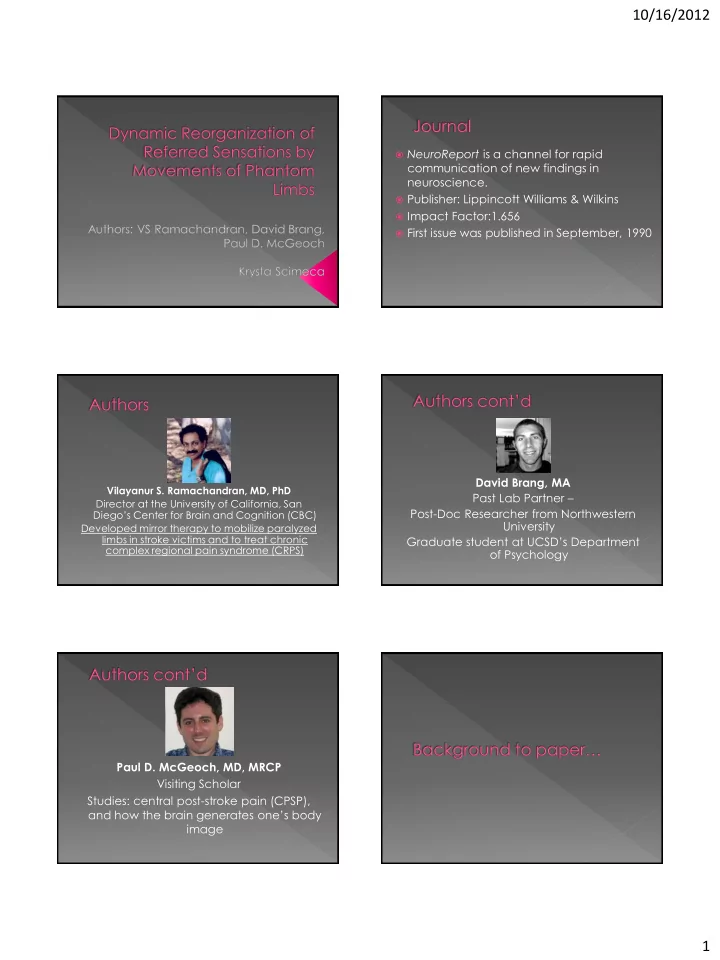

10/16/2012 NeuroReport is a channel for rapid communication of new findings in neuroscience. Publisher: Lippincott Williams & Wilkins Impact Factor:1.656 First issue was published in September, 1990 David Brang, MA Vilayanur S. Ramachandran, MD, PhD Past Lab Partner – Director at the University of California, San Post-Doc Researcher from Northwestern Diego’s Center for Brain and Cognition (CBC) University Developed mirror therapy to mobilize paralyzed limbs in stroke victims and to treat chronic Graduate student at UCSD’s Department complex regional pain syndrome (CRPS) of Psychology Paul D. McGeoch, MD, MRCP Visiting Scholar Studies: central post-stroke pain (CPSP), and how the brain generates one’s body image 1
10/16/2012 Continued experience of sensations and presence of a missing limb after amputation This experiment shows the overlapping of these areas when amputation occurs, and consequently the convergence of somatic sensations in two specific regions of the body 2
10/16/2012 Before amputation, the arm is paralyzed: every time that a sensory message was Painful and difficult (sometimes sent from the motor cortex to the arm, the impossible) to voluntarily move brain continually received contradictory Movable and not painful feedback that the arm was not moving. Paralyzed the brain 'learns' that the arm is fixed in that position. Therefore, when the arm is amputated the brain still 'thinks' the arm is Ramachandran 1996 fixed in the previous position. (Ramachandran, 1996) (Ramachandran, 1996) 3
10/16/2012 “sensory stimuli applied to the ipsilateral face are felt as referred sensations to the missing (phantom) arm, often producing a topographically organized map of the hand on the face with clearly delineated digits described as ‘reference fields’ (RFs) ” ( Ramachandran et al. 2010) “After arm amputation, the sensory input from the face [and shoulder region in the cortex] which normally projects only to the [corresponding] area, ‘invades’ the vacated territory corresponding to the denervated hand” 8 sessions in one day light touch: tip of a blunt pencil cool stimulus: cotton bud simply dipped in ice water 4
10/16/2012 They wondered whether changes in RF topography would occur if the patient were to move his phantom to alter its posture from this resting position For each of the 8 sessions that were performed on D.S. : First: mapped reference fields while in rest position (full pronation) Second: mapped reference fields while in the active position (thumb opposed against fifth finger – partially supinated) This was done on the face and shoulder the and identical results were found each time After 2 months D.S. returned to undergo 10 sessions in one day 5
10/16/2012 The change in topography was limited to touch stimulus. A 2x2 ✗ 2 analysis comparing RFs (thumb/pinky) to phantom position change (rest/movement) yields a significant difference of reported locations to light touch. RFs are dynamic – not static First demonstration of both rapid and large-scale alterations of plasticity of cortical topography Cool stimulus referrals dissociate from light touch and reference fields remain unchanged after movement of the phantom. 6
10/16/2012 http://cbc.ucsd.edu/lab.html http://www.youtube.com/watch?v=sxwn1w7MJvk http://cbc.ucsd.edu/research.html http://www.ebaumsworld.com/video/watch/81807750/ Ramachandran VS, Hirstein W. Perception of phantom limbs. Brain 1998; 121:1603 – 1630. Ramachandran V, Rogers- Ramachandran, D (1996) Synaesthesia in phantom limbs induced with mirrors. Proc R Soc Lond B Biol Sci; 263:377-86. 7
Recommend
More recommend